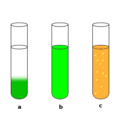Homogeneity facts for kids
Homogeneity (say: hoh-moh-juh-NEE-uh-tee) is a word that describes something that is the same all the way through. Imagine a glass of perfectly mixed juice; every sip tastes the same. That's homogeneity! In science, we often use this word to talk about mixtures. If a mixture is homogeneous, it means you can't see the different parts it's made of, and it looks the same everywhere.
Contents
What is Homogeneity?
Homogeneity means having a uniform structure or composition. Think of it like a smooth, even blend. When something is homogeneous, it means that if you take a sample from one part, it will be exactly like a sample from any other part. There are no lumps, bumps, or separate layers.
Homogeneous Mixtures
A homogeneous mixture is a special kind of mixture. Its parts are so well mixed that you cannot tell them apart just by looking. They blend together perfectly. These mixtures are also called solutions.
- Examples:
- Salt water: When you stir salt into water, the salt disappears. The water looks clear, and every drop tastes salty. You can't see the salt crystals anymore.
- Air: The air we breathe is a mixture of gases like nitrogen, oxygen, and argon. You can't see these different gases, and the air looks the same everywhere.
- Alloys: An alloy is a mixture of metals. For example, brass is an alloy made from copper and zinc. It looks like one solid metal, not separate pieces of copper and zinc.
Pure Substances and Homogeneity
A pure substance is always homogeneous. This is because a pure substance is made of only one type of material. For example, pure water is only H₂O molecules. Pure gold is only gold atoms. Since there's only one type of particle, it's naturally the same all the way through. You won't find different parts in a pure substance.
Homogeneity vs. Heterogeneity
It's helpful to understand homogeneity by comparing it to its opposite: heterogeneity (say: het-uh-roh-juh-NEE-uh-tee).
- Homogeneous: Looks the same throughout. You can't see the different parts. (Example: sugar dissolved in water).
- Heterogeneous: Does NOT look the same throughout. You can easily see the different parts or layers. (Example: a bowl of cereal with milk, where you can see the flakes and the milk separately).
Another example of a heterogeneous mixture is sand mixed with water. You can clearly see the sand particles at the bottom. A salad is also heterogeneous because you can see the different vegetables.
Why is Homogeneity Important?
Understanding homogeneity is important in many areas of science and everyday life.
- Cooking: When you bake a cake, you want the batter to be homogeneous. This ensures that every bite of the cake tastes the same and has the same texture.
- Medicine: Medicines often need to be homogeneous solutions. This way, each dose contains the exact same amount of the active ingredient, making sure it works correctly.
- Industry: In factories, many products need to be homogeneous. For example, paint needs to be a uniform color and consistency so it looks good on a wall.
Images for kids


